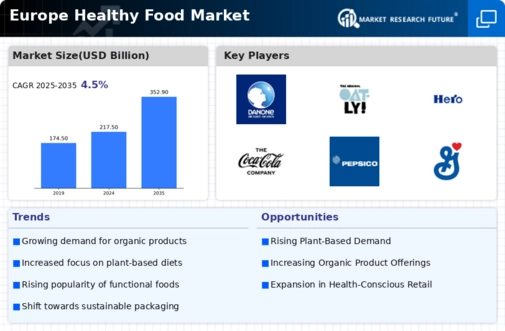The Europe Healthy Food Market is characterized by a dynamic and competitive landscape where a variety of companies vie for consumer attention amidst a growing demand for healthier food alternatives. With increasing awareness of health and wellness among European consumers, the market has seen the emergence of numerous players offering organic, natural, and functional food products. Companies are leveraging innovation, health-centric branding, and sustainable practices to enhance their competitive edge. The market is significantly influenced by trends such as plant-based diets, label products, and the rising popularity of functional foods aimed at boosting health and wellness.
In this evolving landscape, companies are not only competing on product offerings but also focusing on marketing strategies and meeting the regulatory compliance standards that vary across different regions of Europe.Danone stands as a prominent player in the Europe Healthy Food Market, noted for its extensive range of healthy dairy and plant-based products. The company's strength lies in its strong brand recognition and commitment to sustainability, which resonates well with the conscious European consumer.
Danone's focus on innovation allows it to introduce new products that align with current health trends, such as yogurt alternatives and enriched dairy items that cater to specific dietary needs. Its emphasis on high-quality ingredients and transparent sourcing enhances its appeal in this market. Danone's established distribution network across Europe ensures its products are readily accessible, allowing the company to maintain a significant market presence.
The company has also invested in numerous partnerships and initiatives aimed at promoting healthy eating, further solidifying its reputation as a leader in the healthy food segment within Europe.Mars, Incorporated has carved a notable niche in the Europe Healthy Food Market, primarily through its focus on health-conscious snacks and meals. The company offers a diverse portfolio that includes healthy snacks, meal solutions, and specific brands that cater to the wellness sector. Mars has effectively tailored its offerings to meet the nutritional demands of European consumers who seek both convenience and health benefits.
The company's strengths include strong brand loyalty and diversified products that appeal to a wide audience. In recent years, Mars has made strategic acquisitions that bolster its presence in the health food segment, demonstrating its commitment to expanding its footprint in Europe. Furthermore, the company has initiated various sustainability goals that enhance its brand image and align with consumer expectations surrounding environmental responsibility. This strategic alignment enables Mars to compete effectively within the vibrant and rapidly evolving healthy food market across Europe.
























Leave a Comment